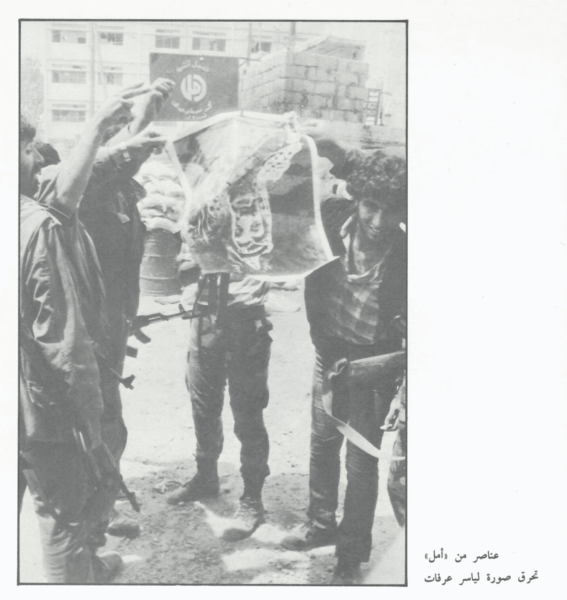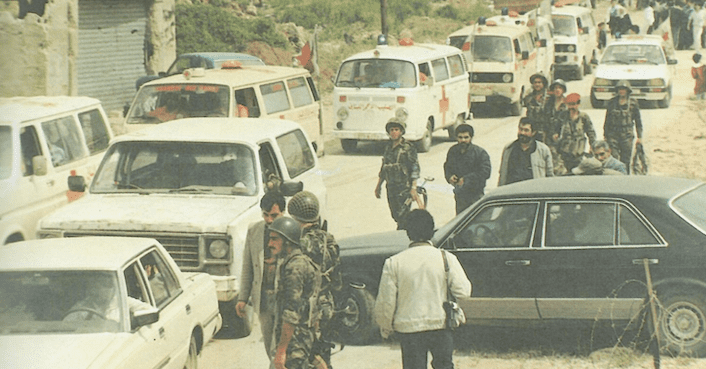Iran, Assad and Hezbollah found in the “Palestinian Cause” a good political tool
History of the Lebanese Civil War was written by the victorious, mainly the Syrian Assad regime, which vilified Christian militias, depicting them as Colonialism’s fifth column that opposed Arab nationalism and its “central cause,” Palestine. Assad regime depicted itself and its Shia allies having been pro-Palestine and anti-West all along. But these were lies.
Until his 1993 peace deal with Israel, Palestinian leader Yasser Arafat spent his life fleeing from two enemies: Israel and Assad.
Pictures in this article are from 1987. The colored one shows Lebanon’s Burj al-Barajneh Palestinian refugee camp, then under siege by the pro-Assad Lebanese Shia militia Amal. The picture was taken during a ceasefire arranged to allow bringing out the injured from Amal’s war on the Palestinian camp. The picture in black and white shows Amal fighters burning pictures of Arafat.
To the Shia, Palestine was always a Sunni problem. When France and the Maronite Church conceived Lebanon in 1920, they imagined a Maronite-led majority of minorities against the Sunnis, who are the majority in most Arab and Muslim countries.
The traditional Maronite policy was pro-West, friendly toward Israel and indifferent toward Palestine. The second biggest in Lebanon’s alliance of minorities was the Shia bloc, which was also pro-West and anti-Palestinian. The Shia position was empowered by Israel’s ally in Iran, Shah Pahlavi.
Such was the original policy of Iranian-Lebanese Shia cleric Musa Sadr, who helped transform Lebanon’s Shia from a bunch of oligarchs and their partisans into an organized sectarian bloc with government-funded institutions.
Like in Lebanon, also in neighboring Syria, the Sunni majority saw in Palestine its cause. Ezzildine al-Qassam, the military wing of the terrorist Palestinian organization Hamas, was named after a Syrian cleric who died in Haifa fighting Jews and the British in the 1930s.
And like the Sunni majority in Syria was pro-Palestine, Syria’s minorities — the biggest of which was the Alawite bloc — were pro-West and anti-Arab nationalism. But ambitious minority leaders saw in their anti-Palestine position an obstacle to climbing the Sunni political ladder, hence Alawite Hafez Assad switched policies, proclaiming Palestine as his cause. He also got on board Lebanon’s Shia and their leader Sadr.
Being pro-Palestine did not necessarily mean supporting Palestinians. Hence Assad spent his life trying to hunt down Arafat. Assad’s Shia proteges in Lebanon, the Amal militia founded by Sadr, also clashed with Arafat’s Palestinian faction in Lebanon, including during the “Siege of the Camps,” as in the picture from 1987.

But starting 1982, Amal found a new way to be anti-Israel: It started the movement of military resistance against Israeli occupation of south Lebanon. While doing so, the Amal militia rarely proclaimed its support of Palestine, but insisted that it was fighting to liberate the Lebanese homeland from Israeli occupation. Amal never got itself to support Palestinians. Assad only pays lip service support to Palestine.
Then came Iran, whose regime found in Palestine a good tool to undermine the sovereignty of Arab Sunni governments and line up Arab Sunnis masses behind Tehran. Until the 1990s, Iran was not yet serious about Palestine despite endorsing anti-Israel slogans. Iran was interested in creating an Islamist society and its corresponding militias. With the end of the Lebanese civil war in 1991 and the disbanding of all militias, Assad allowed Iran and its Hezbollah militia an exception on the condition that they never act independent of his orders, an arrangement that came to its end when the international community forced Assad the son out of Lebanon in 2005.
Since Israeli withdrawal from Lebanon in 2000, Hezbollah has strived to redefine its raison d’etre, one that can justify its unconstitutional armed militia. This prompted Hezbollah to intensify its rhetoric on Palestine and its presumed quest to “liberate Jerusalem.”
The idea that the Shia in Lebanon, Iraq, Iran and Bahrain have, all along, been the champions of the “Palestinian cause” and opposed to the existence of Israel is one big lie. The only ones who believe such lie are Palestinians themselves, and gullible Western Progressives, Woke and the like.
The pictures in this article shed a light on how Assad, Iran and their Shia militias have — over the past 50 years — killed more Palestinians than Israel has done since its inception.
Along these lines came the Assad regime’s massacres against Palestinians in the refugee camp of Yarmouk in Syria in 2015. Assad wanted Palestinians to fight on his side against his opponents. When Palestinians refused, Assad unleashed on them ISIS, then his own forces to presumably clear the camp from ISIS.
The Shia, including the Iran regime, Assad (not a Shia but an Alawite whose allied with the Shia) and Hezbollah, are not sincere in their claims about the “Palestinian cause” and the world does not believe them. The only ones who believe the lies of the Iran regime, Assad and Hezbollah are Palestinians themselves, who seem to be always chasing unrealistic ways out for their decades-old problem, including allying with hypocritical tyrants instead of pursuing clear-eyed solutions.

